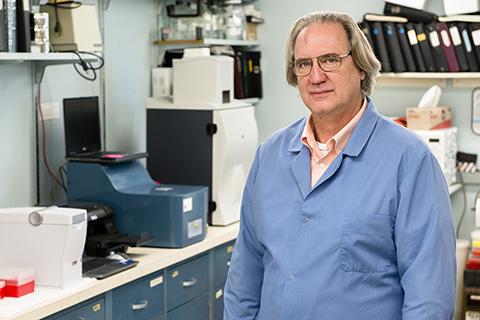Ask Stephen Hughes, Ph.D., to explain his work, and he’ll tell you about teamwork. He sees it as more than just the ubiquitous status quo in science: it is the philosophy that has defined his nearly 35-year career at NCI at Frederick.
“It’s only within the context of a team that most really important research gets done,” said Hughes, who is head of the Vector Design and Replication Section, HIV Dynamics and Replication Program, Center for Cancer Research (CCR), and chief of CCR’s Retroviral Replication Laboratory.
Hughes’ work has focused on retroviruses, mainly HIV, which first caught his attention during the mid-1980s. Over the years, he and his team have made several important contributions to HIV research—though he is quick to point out that they were only possible because many groups came together to perform the work, which involved the skilled scientists in his lab and collaborators at both NCI at Frederick and external institutions.
One example is his team’s work to understand reverse transcriptase, a key enzyme in HIV and other retroviruses, throughout the 1980s and 1990s. In 1991, they published a study, part of a long collaboration with a team of crystallographers (scientists who prepare small crystals of molecules to study their structure) headed by Edward Arnold, Ph.D., Rutgers University, that described the first structure of HIV reverse transcriptase bound to a DNA substrate.
The discovery was a major early step in understanding HIV replication and, eventually, in designing better drugs that can inhibit the replication of the virus and treat the disease. However, it would have been impossible without the combined expertise of the two groups.
Hughes later described the long-standing partnership with Arnold as the “very best and most fruitful collaboration I ever had.”
During the early 2000s, Hughes’ group began work developing therapeutic compounds that treat HIV, an effort that led them to call upon more crystallographers and chemists for help. Their more recent work, which is intended to combat drug-resistant HIV by creating new compounds that inhibit integrase, another HIV enzyme, is based on a similar collaboration. A team of chemists led by Terry Burke, Ph.D., head of the Bioorganic Chemistry Section in CCR’s Chemical Biology Laboratory, designs and synthesizes the inhibitors. The compounds are tested for their ability to inhibit the integrase enzyme by the laboratory of Yves Pommier, M.D., Ph.D., chief of the Developmental Therapeutics Branch, CCR, and their ability to inhibit viral replication by Hughes’ team. The most promising inhibitors are sent to Peter Cherepanov, Ph.D., Imperial College London, for crystallography.
An acclaimed 2014 paper, published in the journal Science, that described a previously unknown mechanism by which HIV survives in patients taking antiretroviral therapy, also depended on collaborators with complementary expertise. Hughes’ group, along with Frank Maldarelli, M.D., Ph.D., head of the Clinical Retrovirology Section in the HIV Dynamics and Replication Program, needed to be able to find one piece of genetic information among trillions of other pieces—something that no human can do.
That task was made possible thanks to a partnership with Xiaolin Wu, Ph.D., principal scientist, Cancer Research Technology Program, Frederick National Laboratory, along with other researchers at the Frederick National Laboratory, Tufts University, and the University of Pittsburgh. Wu’s group not only contributed by performing biochemical assays, but they also developed computational methods to analyze and sort the data.
“In many ways, we succeeded not based only the expertise of a single laboratory, but through an intersection of expertise,” Hughes said.
Hughes’ philosophy is a “two-way street,” and his career includes many instances in which he lent his expertise to others. Recently, he and a colleague, Andrea Ferris, helped scientists at the University of California in a landmark study demonstrating an enhanced CRISPR-Cas technique that appears to hold promise for treating cancer and other diseases. (CRISPR-Cas is a technique for editing DNA in cells.)
His collaborations aren’t confined to the lab, either. Hughes has been a member of NCI at Frederick’s Institutional Biosafety Committee for 30 years, working with other staff to ensure that research involving pathogens, chemicals, and nanomaterials is performed safely. Based on his long tenure, he believes NCI at Frederick is a good environment for exceptional teamwork.
“I think one of the things that’s magic about being here is that, while not all of the complementary expertise we need is here, a lot of it is,” he said. “We get the ability to do what we’re good at, and we rely on others for the things that they’re good at.”


